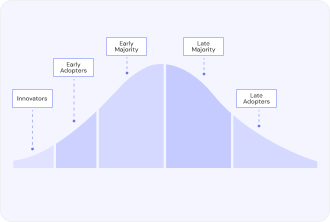Late Adopters Definition

It happens that after the release, the product does not immediately become popular with all the expected users. Suppliers expect one set of figures, but the reality looks a little different and raises concerns about failure. But do not rush to conclusions, because the reason may be just a decrease in indicators due to Late Adopters.
You can create a great functional and convenient offering, but what’s the point if a significant part of the audience is not ready for the state-of-the-art approaches that you have implemented? This is how a certain number of people emerge who could potentially become your users, but are still undecided.
Those who start working with solutions later than others usually agree to innovations after receiving a sufficient number of positive reviews and reactions. They are not ready to use something they have not encountered before and do not know what the result will be, in other words, they are afraid of the unknown and are adherents of traditions and standards. Until Late Adopters see proven benefits and cost effectiveness, convincing them is quite problematic.
Late Adopters: Getting to Know Them Better
Once and again, they appear where the toolset goes beyond the usual framework and may look a little revolutionary or include innovative ideas. This explains the delayed reaction of Late Adopters, since they are used to operating time-tested suites, where the next step can be accurately predicted.
It should be said that on average, their number can be up to 34% of the target audience and therefore they have a significant impact on the potential success of the product. Therefore, when delivering a new release to the market, teams try to think through the coverage of all categories of users: from innovators who are the first to join the ranks of fans, to stragglers who should be given a little more time and attention.
In fact, there is no need to be afraid of Late Adopters, because their presence is an integral part of the deployment life cycle. But it will not be superfluous to take into account their profile and main characteristics, especially when planning marketing and sales strategies.
How to convince Late Adopters?
Most often, the problem is not in the asset itself, but in the unpreparedness of such users for rapid digital transformation. Sometimes they are unsure of the value of such innovations for themselves, and sometimes they doubt that the time spent will not meet expectations.
In order for the team releasing the offer to the market to act systematically, there are a number of measures and strategies that lead to greater involvement of laggards. Let’s list some of the main ones.
- Identifying and defining these people. This should be the first step in order to effectively target further efforts.
- Defining the reasons for doubts. Next, it is worth determining what exactly prevents Late Followers from getting to know the result better and eliminating doubts or objections by testing the usability of the invention or a clearer presentation of its bonuses. For this, you can use surveys, research, the introduction of additional services and guarantees, as well as the correct positioning of utilities.
- Planning possible price bonuses. In addition to the fear of the new, laggards are also more price-sensitive than early adopters and are often greedy for promotions as they look for a bargain.
- Showcasing practical benefits. Don’t just focus on following the latest fad or trend. By highlighting proven success, case studies can help build trust and provide social proof.
Use targeted marketing, differentiated positioning that appeals to different user groups differently and don’t lose a third of your audience!